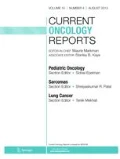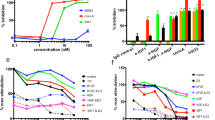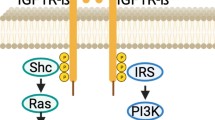Abstract
For approximately two decades, the insulin-like growth factor (IGF) has been implicated in the pathogenesis of numerous pediatric malignancies, including osteosarcoma, Ewing sarcoma, and rhabdomyosarcoma. In the past, major toxicities have limited the clinical development of IGF-targeted therapies. However, recent interest has been heightened by the availability of increasingly specific small molecules and antibodies directed at IGF-I receptor. Preclinical data using these inhibitors against xenograft models of pediatric sarcomas, coupled with responses in adults with Ewing sarcoma, have generated significant excitement about the clinical potential of this class of drugs and have driven the rapid development of numerous clinical trials now under way. This article reviews the preclinical data and the ongoing clinical trials, as well as issues regarding the further development of these drugs specifically for pediatric malignancies.
Similar content being viewed by others
References and Recommended Reading
Jones JI, Clemmons DR: Insulin-like growth factors and their binding proteins: biological actions. Endocr Rev 1995, 16:3–34.
Rikhof B, de Jong S, Suurmeijer AJ, et al.: The insulin-like growth factor system and sarcomas. J Pathol 2009, 217:469–482.
Hermanto U, Zong CS, Wang LH: Inhibition of mitogen-activated protein kinase kinase selectively inhibits cell proliferation in human breast cancer cells displaying enhanced insulin-like growth factor I-mediated mitogen-activated protein kinase activation. Cell Growth Differ 2000, 11:655–664.
Kurmasheva RT, Houghton PJ: IGF-I mediated survival pathways in normal and malignant cells. Biochim Biophys Acta 2006, 1766:1–22.
Samani AA, Yakar S, LeRoith D, Brodt P: The role of the IGF system in cancer growth and metastasis: overview and recent insights. Endocr Rev 2007, 28:20–47.
Sarfstein R, Maor S, Reizner N, et al.: Transcriptional regulation of the insulin-like growth factor-I receptor gene in breast cancer. Mol Cell Endocrinol 2006, 252:241–246.
Arndt CA, Crist WM: Common musculoskeletal tumors of childhood and adolescence. N Engl J Med 1999, 341:342–352.
Barr FG: Gene fusions involving PAX and FOX family members in alveolar rhabdomyosarcoma. Oncogene 2001, 20:5736–5746.
Scrable HJ, Witte DP, Lampkin BC, Cavenee WK: Chromosomal localization of the human rhabdomyosarcoma locus by mitotic recombination mapping. Nature 1987, 329:645–647.
Yun K: A new marker for rhabdomyosarcoma. Insulin-like growth factor II. Lab Invest 1992, 67:653–664.
Wan X, Helman LJ: Levels of PTEN protein modulate Akt phosphorylation on serine 473, but not on threonine 308, in IGF-II-overexpressing rhabdomyosarcomas cells. Oncogene 2003, 22:8205–8211.
El-Badry OM, Minniti C, Kohn EC, et al.: Insulin-like growth factor II acts as an autocrine growth and motility factor in human rhabdomyosarcoma tumors. Cell Growth Differ 1990, 1:325–331.
Petricoin EF 3rd, Espina V, Araujo RP, et al.: Phosphoprotein pathway mapping: Akt/mammalian target of rapamycin activation is negatively associated with childhood rhabdomyosarcoma survival. Cancer Res 2007, 67:3431–3440.
Cao L, Yu Y, Darko I, et al.: Addiction to elevated insulin-like growth factor I receptor and initial modulation of the AKT pathway define the responsiveness of rhabdomyosarcoma to the targeting antibody. Cancer Res 2008, 68:8039–8048.
Kalebic T, Tsokos M, Helman LJ: In vivo treatment with antibody against IGF-1 receptor suppresses growth of human rhabdomyosarcoma and down-regulates p34cdc2. Cancer Res 1994, 54:5531–5534.
Kolb EA, Gorlick R, Houghton PJ, et al.: Initial testing (stage 1) of a monoclonal antibody (SCH 717454) against the IGF-1 receptor by the pediatric preclinical testing program. Pediatr Blood Cancer 2008, 50:1190–1197.
Kolb EA, Morton CL, Houghton PJ, et al.: Pediatric preclinical testing program (PPTP) evaluation of the fully human anti-IGF-1R antibody IMC-A12. Eur J Cancer 2008, 6:176.
Shapiro DN, Jones BG, Shapiro LH, et al.: Antisense-mediated reduction in insulin-like growth factor-I receptor expression suppresses the malignant phenotype of a human alveolar rhabdomyosarcoma. J Clin Invest 1994, 94:1235–1242.
Kalebic T, Blakesley V, Slade C, et al.: Expression of a kinase-deficient IGF-I-R suppresses tumorigenicity of rhabdomyosarcoma cells constitutively expressing a wild type IGF-I-R. Int J Cancer 1998, 76:223–227.
Manning BD: Balancing Akt with S6K: implications for both metabolic diseases and tumorigenesis. J Cell Biol 2004, 167:399–403.
Wan X, Harkavy B, Shen N, et al.: Rapamycin induces feedback activation of Akt signaling through an IGF-1R-dependent mechanism. Oncogene 2007, 26:1932–1940.
Merlino G, Helman LJ: Rhabdomyosarcoma—working out the pathways. Oncogene 1999, 18:5340–5348.
Florini JR, Ewton DZ, Coolican SA: Growth hormone and the insulin-like growth factor system in myogenesis. Endocr Rev 1996, 17:481–517.
Cooke DW, Bankert LA, Roberts CT Jr, et al.: Analysis of the human type I insulin-like growth factor receptor promoter region. Biochem Biophys Res Commun 1991, 177:1113–1120.
Zhang L, Zhan S, Navid F, et al.: AP-2 may contribute to IGF-II overexpression in rhabdomyosarcoma. Oncogene 1998, 17:1261–1270.
Epstein JA, Lam P, Jepeal L, et al.: Pax3 inhibits myogenic differentiation of cultured myoblast cells. J Biol Chem 1995, 270:11719–11722.
Scheidler S, Fredericks WJ, Rauscher FJ 3rd, et al.: The hybrid PAX3-FKHR fusion protein of alveolar rhabdomyosarcoma transforms fibroblasts in culture. Proc Natl Acad Sci U S A 1996, 93:9805–9809.
Wang W, Kumar P, Epstein J, et al.: Insulin-like growth factor II and PAX3-FKHR cooperate in the oncogenesis of rhabdomyosarcoma. Cancer Res 1998, 58:4426–4433.
Xu Q, Wu Z: The insulin-like growth factor-phosphatidylinositol 3-kinase-Akt signaling pathway regulates myogenin expression in normal myogenic cells but not in rhabdomyosarcoma-derived RD cells. J Biol Chem 2000, 275:36750–36757.
Ladanyi M: EWS-FLI1 and Ewing’s sarcoma: recent molecular data and new insights. Cancer Biol Ther 2002, 1:330–336.
de Alava E, Panizo A, Antonescu CR, et al.: Association of EWS-FLI1 type 1 fusion with lower proliferative rate in Ewing’s sarcoma. Am J Pathol 2000, 156:849–855.
Arvand A, Denny CT: Biology of EWS/ETS fusions in Ewing’s family tumors. Oncogene 2001, 20:5747–5754.
Torchia EC, Jaishankar S, Baker SJ: Ewing tumor fusion proteins block the differentiation of pluripotent marrow stromal cells. Cancer Res 2003, 63:3464–3468.
Riggi N, Cironi L, Provero P, et al.: Development of Ewing’s sarcoma from primary bone marrow-derived mesenchymal progenitor cells. Cancer Res 2005, 65:11459–11468.
Toretsky JA, Kalebic T, Blakesley V, et al.: The insulin-like growth factor-I receptor is required for EWS/FLI-1 transformation of fibroblasts. J Biol Chem 1997, 272:30822–308227.
Yee D, Favoni RE, Lebovic GS, et al.: Insulin-like growth factor I expression by tumors of neuroectodermal origin with the t(11;22) chromosomal translocation. A potential autocrine growth factor. J Clin Invest 1990, 86:1806–1814.
Prieur A, Tirode F, Cohen P, Delattre O: EWS/FLI-1 silencing and gene profiling of Ewing cells reveal downstream oncogenic pathways and a crucial role for repression of insulin-like growth factor binding protein 3. Mol Cell Biol 2004, 24:7275–7283.
Toretsky JA, Thakar M, Eskenazi AE, Frantz CN: Phosphoinositide 3-hydroxide kinase blockade enhances apoptosis in the Ewing’s sarcoma family of tumors. Cancer Res 1999, 59:5745–5750.
Gorlick R, Anderson P, Andrulis I, et al.: Biology of childhood osteogenic sarcoma and potential targets for therapeutic development: meeting summary. Clin Cancer Res 2003, 9:5442–5453.
McCarthy TL, Centrella M: Local IGF-I expression and bone formation. Growth Horm IGF Res 2001, 11:213–219.
Burrow S, Andrulis IL, Pollak M, Bell RS: Expression of insulin-like growth factor receptor, IGF-1, and IGF-2 in primary and metastatic osteosarcoma. J Surg Oncol 1998, 69:21–27.
Pollak M, Sem AW, Richard M, et al.: Inhibition of metastatic behavior of murine osteosarcoma by hypophysectomy. J Natl Cancer Inst 1992, 84:966–971.
Savage SA, Woodson K, Walk E, et al.: Analysis of genes critical for growth regulation identifies Insulin-like Growth Factor 2 Receptor variations with possible functional significance as risk factors for osteosarcoma. Cancer Epidemiol Biomarkers Prev 2007, 16:1667–1674.
Ladanyi M: Fusions of the SYT and SSX genes in synovial sarcoma. Oncogene 2001, 20:5755–5762.
Allander SV, Illei PB, Chen Y, et al.: Expression profiling of synovial sarcoma by cDNA microarrays: association of ERBB2, IGFBP2, and ELF3 with epithelial differentiation. Am J Pathol 2002, 161:1587–1595.
Sun Y, Gao D, Liu Y, et al.: IGF2 is critical for tumorigenesis by synovial sarcoma oncoprotein SYT-SSX1. Oncogene 2006, 25:1042–1052.
de Bruijn DR, Allander SV, van Dijk AH, et al.: The synovial-sarcoma-associated SS18-SSX2 fusion protein induces epigenetic gene (de)regulation. Cancer Res 2006, 66:9474–9482.
Xie Y, Skytting B, Nilsson G, et al.: Expression of insulin-like growth factor-1 receptor in synovial sarcoma: association with an aggressive phenotype. Cancer Res 1999, 59:3588–3591.
Karnieli E, Werner H, Rauscher FJ 3rd, et al.: The IGF-I receptor gene promoter is a molecular target for the Ewing’s sarcoma-Wilms’ tumor 1 fusion protein. J Biol Chem 1996, 271:19304–19309.
Morrison KB, Tognon CE, Garnett MJ, et al.: ETV6-NTRK3 transformation requires insulin-like growth factor 1 receptor signaling and is associated with constitutive IRS-1 tyrosine phosphorylation. Oncogene 2002, 21:5684–5695.
Author information
Authors and Affiliations
Corresponding author
Rights and permissions
About this article
Cite this article
Kolb, E.A., Gorlick, R. Development of IGF-IR inhibitors in pediatric sarcomas. Curr Oncol Rep 11, 307–313 (2009). https://doi.org/10.1007/s11912-009-0043-1
Published:
Issue Date:
DOI: https://doi.org/10.1007/s11912-009-0043-1




